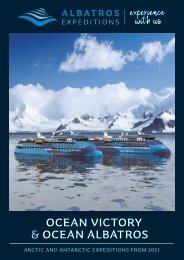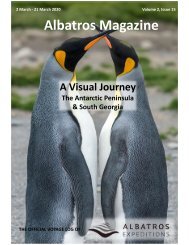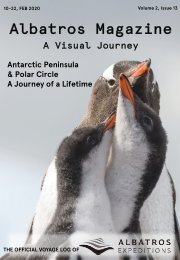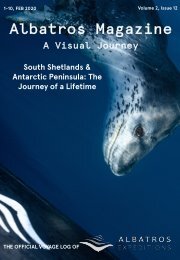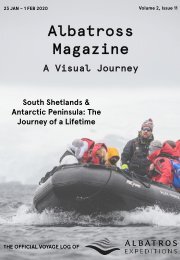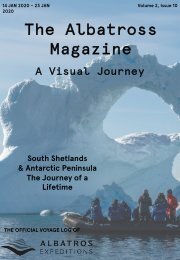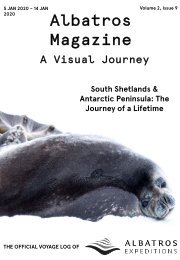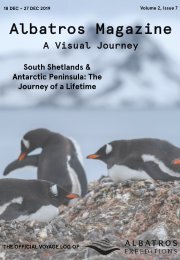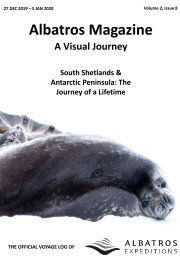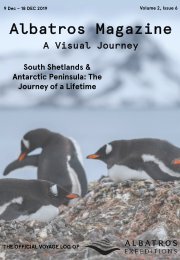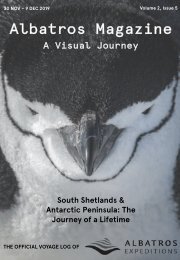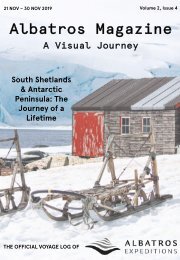South Shetlands & The Antarctic Peninsula 22 Feb 2020 - 14
You also want an ePaper? Increase the reach of your titles
YUMPU automatically turns print PDFs into web optimized ePapers that Google loves.
<strong>22</strong> FEB- 2 March <strong>2020</strong><br />
Volume 2, Issue <strong>14</strong><br />
Albatros Magazine<br />
A Visual Journey<br />
<strong>South</strong> <strong>Shetlands</strong> &<br />
<strong>The</strong> <strong>Antarctic</strong> <strong>Peninsula</strong><br />
THE OFFICIAL VOYAGE LOG OF
Albatros Magazine: A Visual Journey<br />
Editor-in-Chief:<br />
Layout & Design:<br />
Amanda Dalsgaard<br />
Gaby Pilson & Shelli Ogilvy<br />
Front Cover Image:<br />
Back Cover Image:<br />
Photography Contributors:<br />
Gentoo Family Shayne Mcguire<br />
Elephant seal Sandra Petrowiz<br />
Sandra Petrowitz<br />
Yuri Choufour<br />
Werner Kruse<br />
Renato Granieri<br />
Gaby Pilson<br />
Shannon Jensen<br />
Shayne Mcguire<br />
Phillip Hunter<br />
Amanda Dalsgaard<br />
<strong>22</strong> FEB- 2 March <strong>2020</strong> Volume 2, Issue <strong>14</strong>
TABLE OF CONTENTS<br />
<strong>The</strong> Voyage<br />
Meet the Team<br />
Day 1: <strong>South</strong>ward Bound<br />
<strong>The</strong> Seven Sisters of Szczecin<br />
An Unlikely <strong>Antarctic</strong> Explorer<br />
Day 2: Rolling Our Way <strong>South</strong><br />
Penguins! Fun Facts for the <strong>Antarctic</strong> Adventurer<br />
Day 3: Our Our Way to <strong>Antarctic</strong>a!<br />
Ice is Nice – Glacier Fun Facts<br />
Whales: Friendly Giants of the Sea<br />
Day 4: Our First Day in <strong>Antarctic</strong>a<br />
<strong>The</strong> Geological Structure of the <strong>Antarctic</strong> <strong>Peninsula</strong><br />
Day 5: In the Footsteps of Charcot<br />
When and How the Earth Got Cold<br />
Day 6: <strong>The</strong> White Continent<br />
Fire in the <strong>Antarctic</strong><br />
Day 7: <strong>The</strong> Final Stop Among the <strong>South</strong> <strong>Shetlands</strong><br />
Day 8: Northward Bound<br />
<strong>Antarctic</strong>a: A Continent for Science<br />
A Brief History of the Zodiac<br />
Day 9: <strong>The</strong> Beagle Channel<br />
King of the <strong>South</strong>ern Winds<br />
Day 10: Home Again<br />
By the Numbers<br />
A Final Note<br />
3<br />
4<br />
5<br />
6<br />
7<br />
8<br />
9<br />
10<br />
11<br />
13<br />
<strong>14</strong><br />
15<br />
16<br />
18<br />
19<br />
21<br />
<strong>22</strong><br />
25<br />
27<br />
29<br />
30<br />
32<br />
33<br />
34<br />
35
<strong>The</strong> Voyage<br />
3<br />
<strong>The</strong> following map traces the approximate route that the M/V Ocean Atlantic took during<br />
our voyage to <strong>Antarctic</strong>a. You can find more information about our day to day activities,<br />
landings, and excursions on the following pages. We hope that this magazine serves as a<br />
reminder of all of the wonderful memories you made while experiencing the <strong>Antarctic</strong> with.<br />
o<br />
<strong>22</strong> FEB- 2 March <strong>2020</strong><br />
Volume 2, Issue <strong>14</strong>
4<br />
Shelli Ogilvy<br />
Assistant Expedition<br />
Leader<br />
Samuel Gagnon<br />
Expedition Leader<br />
Barbara Post<br />
Assistant Expedition<br />
Leader<br />
Ted Creek<br />
Zodiac Master<br />
David Reid<br />
Kayak Master<br />
Wan Meng Chieh<br />
Kayak Guide<br />
Isabelle Howells<br />
Equipment Master<br />
Nadine Smith<br />
Shop Manager<br />
Rose Li<br />
Guide<br />
Christophe Gouraud<br />
Lecturer & Guide<br />
Shayne McGuire<br />
Photographer<br />
Amanda Dalsgaard<br />
Lecturer & Guide<br />
Kevin Burke<br />
Lecture & Guide<br />
Ab Steenvoorden<br />
Lecturer & Guide<br />
Lisa Pettenuzzo<br />
Lecturer & Guide<br />
Mariam Pousa<br />
Lecturer & Guide<br />
Christina Langer<br />
First Aid Responder<br />
Marta<br />
Lecturer & Guide<br />
Sanna Kallio<br />
Lecturer & Guide<br />
Chloe Shang<br />
Shop Assistent<br />
Steve Egan<br />
Guest Services<br />
Rashidah Lim<br />
Guide<br />
<strong>22</strong> FEB- 2 March <strong>2020</strong><br />
Volume 2, Issue <strong>14</strong>
5<br />
Day 1 - <strong>South</strong>ward Bound<br />
<strong>22</strong> <strong>Feb</strong>ruary <strong>2020</strong> - Embarkation Day<br />
From all over the world, passengers arrived on the<br />
dock in Ushuaia for a 15:00 embarkation onto the<br />
M/V Ocean Atlantic. Our <strong>Antarctic</strong> expedition was<br />
finally coming to fruition.<br />
<strong>The</strong> ship’s doctor all the guest’s by taking body<br />
temperature readings with a small gun shaped<br />
thermometer that he pointed at everyone’s<br />
foreheads. It was a funny way to welcome people,<br />
but we were glad for the precautionary measures<br />
with ‘Corona-virus’ spreading around the world.<br />
One of the expedition guides joked that they were<br />
uploading memories of <strong>Antarctic</strong>a for us and then<br />
going to send us home again! Ha.<br />
After we checked into our rooms and had some<br />
tea, we were given a safety briefing and practiced<br />
an emergency drill. <strong>The</strong> sound of the seven short<br />
blasts and one long was not to be mistaken. We<br />
gathered at our muster stations for roll call and<br />
learned where the lifeboats are.<br />
We reconvened in the Viking <strong>The</strong>atre for a ‘meet<br />
and greet’ with the ship’s Crew and Expedition<br />
Team. Our Expedition Leader, Sam, introduced us<br />
to the Hotel director Oliver, who proudly<br />
introduced his team that would be taking care of<br />
us for the duration of the trip. Following this, was<br />
an introduction of the Expedition Team.<br />
We dinned as the sun set and the glassy Beagle<br />
Channel gave way under us. <strong>The</strong> farms of the<br />
southernmost residents in <strong>South</strong> America were<br />
picturesque against the rugged mountains jutting<br />
out seemingly just a stone’s throw away on either<br />
side of the narrow channel. <strong>The</strong> dining room<br />
buzzed with excitement as we exchanged stories<br />
with our new travel companions answering the<br />
question, “…so what made you want to come to<br />
<strong>Antarctic</strong>a?”<br />
After dinner the warm summer air of the<br />
continent, lured us out onto the decks to watch<br />
the albatross, terns and skuas dance in the ship’s<br />
wake. What a beautiful evening, and the salty<br />
fresh air so calming; such a grand way to wind<br />
down for bed and get a good sleep. Tomorrow will<br />
be an exciting day on the Drake Passage.<br />
<strong>22</strong> FEB- 2 March <strong>2020</strong><br />
Volume 2, Issue <strong>14</strong>
<strong>The</strong> Seven Sisters of Szczecin<br />
David MacDonald, Lecturer (Geology) & Expedition Guide<br />
6<br />
M/V Ocean Atlantic was launched in 1986 as the last-built of the ‘Shoshtakovich’ class of ice-strengthened<br />
passenger vessels, alongside six sister ships, together known as the “Seven Sisters of Szczecin.<br />
Her original name was Konstantin Chernenko<br />
(Константин Черненко), after the President of the<br />
USSR (1984-1985). She was renamed Russ (Русс) in<br />
1989, and spent much of her life working in the Russian<br />
Far East.<br />
She was purchased by Albatros Expeditions and<br />
completely refitted in 2017. She is now a 200-<br />
passenger expedition vessel and is one of the strongest<br />
polar cruise ships afloat. Here are some fun facts about<br />
the “Seven Sisters”:<br />
• All seven ships were built by Stocnia Szczecinska<br />
shipyard in Szczecin, Poland between 1979-1986<br />
• Main engines: 4 x Skoda Sulzer 6LZ40 total power<br />
12800 kW, giving a maximum speed of 18 knots<br />
• Most of the class have one bow thruster (736 kW)<br />
and one stern thruster (426 kW); however, two<br />
ships, including ours, built in 1986, have two stern<br />
thrusters, each of 426 kW<br />
• Feature Siemens stabilisers for seaworthiness<br />
• Although built as ferries, they have a strengthened<br />
car deck for transport of tanks<br />
• Two of them had diving chambers<br />
• MV Mikhail Sholokov had hull demagnetising<br />
equipment so it could operate in minefields<br />
• All of these ships have been scrapped except ours<br />
and Konstantin Simonov – now Ocean Endeavour<br />
Our ship has had a complex history:<br />
1986-1987 In Baltic traffic, then Vladivostok to<br />
Japan & S Korea<br />
1989 renamed to Russ<br />
1997-1999 In traffic Stockholm-Riga; 2000<br />
Odessa-Haifa; 2002 back to<br />
Vladivostok transporting cars from<br />
Japan<br />
2007 Sold to Sea Ferry Shipping in Majuro<br />
and renamed 2010 to Atlantic;<br />
renovations in Italy and in traffic<br />
Stockholm-Helsinki-St. Petersburg<br />
during summer and laid up (October<br />
2010) in St Petersburg<br />
2012 Sold to ISP in Miami and renamed to<br />
Ocean Atlantic under Marshall<br />
Islands flag<br />
2013 Used as a hotel ship in the German<br />
bight wind farm project<br />
2015-2017 Laid up in Helsingborg and taken to<br />
Gdansk in Poland, where totally<br />
refitted<br />
2017 Chartered to Quark Expeditions<br />
2017-present Chartered to Albatros Expeditions.<br />
<strong>22</strong> FEB- 2 March <strong>2020</strong><br />
Volume 2, Issue <strong>14</strong>
An Unlikely <strong>Antarctic</strong> Explorer<br />
Gregers Gjersøe – Snowshoe Master & Expedition Guide<br />
In a suburb of Wellington, New Zealand, the local<br />
cemetery is home to a rather unassuming grave.<br />
<strong>The</strong> final resting place of Henry “Chippy” McNish,<br />
one of the survivors of Sir Ernest Shackleton’s<br />
19<strong>14</strong> Endurance Expedition, the grave is also a<br />
memorial to one of the most improbable of<br />
<strong>Antarctic</strong> explorers.<br />
McNish himself was a carpenter onboard the<br />
Endurance, though he didn’t travel alone. During<br />
the expedition, McNish brought along a cat that<br />
followed him around like an overpossessive<br />
wife. Soon enough, the<br />
crew named the cat Mrs. Chippy,<br />
although the expedition quickly<br />
realised that Mrs. Chippy was a<br />
gentleman, not a lady.<br />
Mrs. Chippy was an unusual cat,<br />
though an avid adventurer,<br />
having climbed the Endurance’s<br />
rigging lines on several<br />
occasions. Mrs. Chippy also did<br />
some very provocative strolls<br />
across the roofs of the dogs’ kennels<br />
and even once fell into the frigid water<br />
below. Thankfully, the crew heard her cries and<br />
quickly turned the ship around so they could<br />
pluck her up from the icy cold waters and get her<br />
to safety.<br />
Also onboard the Endurance was a young man -<br />
Perce Blackborow. Perce had travelled to Buenos<br />
Aires looking for new employment, but wasn’t<br />
hired; at 18, his youth and inexperience counted<br />
against him. Somehow, he managed to sneak<br />
aboard the ship, and he hid in a clothing locker<br />
for three days. Eventually, he was discovered,<br />
and Shackleton was furious with him, but was<br />
sent to work in the galley where he became great<br />
friends with Mrs. Chippy.<br />
In January of 1915, the Endurance got trapped in<br />
the <strong>Antarctic</strong> pack ice. McNish's work prevented<br />
the ship from flooding, but he couldn’t do<br />
anything to stop it from being crushed. <strong>The</strong> ship<br />
was abandoned and, much to McNish’s despair,<br />
Shackleton ordered Mrs. Chippy to be shot, as<br />
they couldn’t take her on their survival journey.<br />
Now, the group had to make it back to safety. For<br />
months, the expedition drifted through icy<br />
waters until they made it to Elephant Island.<br />
Once at Elephant Island, Shackleton set out<br />
in a <strong>22</strong>-foot-long open boat and made<br />
an 800-mile crossing through the<br />
rough waters of the <strong>South</strong> Atlantic<br />
to <strong>South</strong> Georgia. McNish was<br />
one of the five men who<br />
accompanied Shackleton,<br />
making improvements to the<br />
boat to make the voyage<br />
possible.<br />
For the next fifteen years, McNish<br />
lived a difficult life in Wellington<br />
before passing away in 1930. He never<br />
forgave Shackleton for shooting Mrs.<br />
Chippy.<br />
Nearly 30 years later, in 1959, the New Zealand<br />
<strong>Antarctic</strong> Society realised that McNish had been<br />
given a very poor burial in an unmarked grave.<br />
<strong>The</strong> Society raised funds for a headstone and<br />
even reunited McNish and Mrs. Chippy by adding<br />
a life-sized bronze statue of Mrs. Chippy to the<br />
grave.<br />
Now Karori Cemetery near Wellington is a<br />
pilgrimage site for <strong>Antarctic</strong> history buffs, who<br />
visit McNish’s grave and see Mrs. Chippy<br />
watching over him once again.<br />
7<br />
<strong>22</strong> FEB- 2 March <strong>2020</strong><br />
Volume 2, Issue <strong>14</strong>
Day 2 - Rolling Our Way <strong>South</strong><br />
23 <strong>Feb</strong>ruary <strong>2020</strong> – Drake Passage <strong>South</strong><br />
8<br />
A rocking and rolling sea greeted us for our first<br />
full day together onboard the Ocean Atlantic as<br />
she sailed us southwards toward the promise of a<br />
snowy white continent, lost at the edge of the<br />
known world. A lovely breakfast as the skies<br />
lightened, gave us a nutritious beginning for the<br />
events of the day. It was a relaxed yet<br />
adventurous start as many of us were still finding<br />
our sea legs as our ship lurched challengingly<br />
across the Drake Passage.<br />
@ShayneMcguire<br />
Our ornithologist Ab rolled out an entertaining<br />
introduction to the Seabirds of the <strong>South</strong>ern<br />
Ocean, surprisingly, given the conditions, to a full<br />
house, providing us a great taste of the<br />
encounters we could look forward to with these<br />
feathered friends who accompany us on our<br />
passage to <strong>Antarctic</strong>a. Interest was high and the<br />
theatre full of curious questions about our winged<br />
companions. Time ‘flew’ and before we knew it, it<br />
was time for a mandatory IAATO briefing. After<br />
Expedition leader Sam gave us a preview of some<br />
introductory thoughts and perspectives about<br />
<strong>Antarctic</strong>a and how to be a respectful tourist, we<br />
enjoyed a great lunch put on by our consistently<br />
creative galley team, fueling us for an afternoon of<br />
further activities.<br />
After lunch and a siesta for many of us, Amanda<br />
welcomed those up and about to an excellent<br />
overview of the whales we may encounter in the<br />
region, giving us some important understanding of<br />
the lives and ways of these most engaging<br />
creatures of the seas we were entering.<br />
Throughout the afternoon as the sea state<br />
continued, many of us wandered out on the aft<br />
deck to inspect the view of the wild seas, mingled<br />
with our naturalists and other travelers over tea,<br />
or photographed the many wondrous seabirds<br />
that chaperoned our sea journey.<br />
A sweet snack at tea time flowed into an invitation<br />
to join Shayne for her valuable insights and tips on<br />
photographing in <strong>Antarctic</strong>a. Soon enough, a day<br />
of various briefings, social occasions and<br />
educational presentations brought us to our<br />
official welcome to the journey by the Master of<br />
our vessel and our captain Georgii as he toasted to<br />
an expected successful Expedition ahead. This<br />
toast lead us into a delightful evening meal as we<br />
steamed south towards the horizon. Some<br />
gathered after dining for a screening of Frozen<br />
Planet to fuel dreams of the icy realms ahead.<br />
Late in the night, we would cross the <strong>Antarctic</strong><br />
Convergence-the gateway into <strong>Antarctic</strong>a’s unique<br />
biological zone and would soon consider ourselves<br />
embraced by the great white continent.<br />
@ShayneMcguire<br />
<strong>22</strong> FEB- 2 March <strong>2020</strong><br />
Volume 2, Issue <strong>14</strong>
Penguins! Fun Facts for the <strong>Antarctic</strong> Adventurer<br />
Gaby Pilson, Hiking Master & Expedition Guide<br />
For many of us, the chance to see penguins waddling around in the snowy vastness of <strong>Antarctic</strong>a is the reason<br />
that we came to the White Continent. <strong>The</strong>se charismatic sea birds are a fan-favourite for visitors to <strong>Antarctic</strong>a,<br />
but even cuddly-looking penguins are incredibly well adapted to one of the harshest environments on Earth.<br />
9<br />
1<br />
2<br />
3<br />
4<br />
5<br />
Depending on what book you read, there are 19<br />
species of penguins. If you count all of the<br />
subspecies, there are 25 total varieties of<br />
penguins in the world, however, there are only<br />
four truly <strong>Antarctic</strong> species of penguins: the<br />
Adélie, Gentoo, Chinstrap, and Emperor. All of<br />
the other penguins in the world live south of the<br />
equator yet north of <strong>Antarctic</strong>a, with the<br />
exception of one species in the Galapagos whose<br />
range barely crosses into the northern<br />
hemisphere.<br />
<strong>The</strong> largest penguin to have ever lived was the<br />
now-extinct mega penguin, which weighed some<br />
115 kg. <strong>The</strong>se days, the largest penguin is the<br />
Emperor Penguin, which tips the scales at 23 kg.<br />
Alternatively, the smaller gentoo penguin weighs<br />
just 15 kg.<br />
Although they nest, breed, and socialize on land,<br />
penguins rely on the sea for survival. As<br />
swimming and diving birds, penguins are adept<br />
at fishing and must head to the ocean for their<br />
sustenance. Indeed, the deepest diving bird in<br />
the world is the Emperor Penguin, with a<br />
record-breaking dive of 535 meters!<br />
Penguins are amazing swimmers. <strong>The</strong>y spend<br />
much of their day searching for food in the<br />
ocean, particularly for their favourite meal of<br />
krill, squid, and small fish. <strong>The</strong> fastest swimming<br />
penguin is the Gentoo, which is known to reach<br />
speeds of upwards of 50 kilometres an hour<br />
while zooming through the water.<br />
Penguins are highly social birds, choosing to<br />
nest in large colonies, where they will also raise<br />
their young. Many penguin chicks, after<br />
hatching stay with their parents for a few weeks<br />
to a few months before forming large “crechés,”<br />
many hundreds of individual teenage penguins<br />
in size.<br />
<strong>22</strong> FEB- 2 March <strong>2020</strong><br />
Volume 2, Issue <strong>14</strong>
Day 3 – On Our Way to <strong>Antarctic</strong>a!<br />
24 <strong>Feb</strong>ruary <strong>2020</strong> – Drake Passage <strong>South</strong><br />
10<br />
Our second day at sea, and already people were<br />
getting used to the motion of the ship through the<br />
waves and were becoming accustomed to life on<br />
the water. Today, we had a few more tasks to<br />
prepare ourselves for our first landing, including a<br />
briefing on how to safely travel in the zodiacs.<br />
<strong>Antarctic</strong>a is a unique environment with a<br />
sensitive ecosystem, that can easily be disturbed<br />
by visitors. Because of this, we take extra<br />
precautions with the equipment that is taken<br />
onshore to check that it doesn’t have any seeds of<br />
vegetation that could cause a nuisance to the local<br />
area. Having made sure our outdoor kit was biosecure,<br />
we piled into the lecture theatre with<br />
plates loaded with tea-time treats and settled in<br />
for Christophe’s presentation about penguins.<br />
For many, seeing penguins will be one of the<br />
highlights of visiting the <strong>Antarctic</strong> <strong>Peninsula</strong>, and<br />
for good reason. <strong>The</strong>se charismatic critters are so<br />
at home in this hostile environment and that is<br />
thanks to some of the interesting adaptations that<br />
they have. Christophe talked us through some<br />
remarkable facts about their life cycle, their<br />
hunting habits and their breeding and social lives.<br />
<strong>The</strong> briefing, which explained the plans of our first<br />
landing, and recap was followed by a delicious<br />
dinner in the Vinland Restaurant. That evening,<br />
our fellow guest on board, Kurt, gave a moving<br />
and inspiring talk to a full house, giving us the<br />
opportunity to learn about the charity he is<br />
involved with that provides education, resources<br />
and nourishing meals to children with disabilities.<br />
.<br />
@ShayneMcguire<br />
<strong>22</strong> FEB- 2 March <strong>2020</strong><br />
All photos © Sandra Petrowitz<br />
Volume 2, Issue <strong>14</strong>
Ice is Nice – Glacier Fun Facts<br />
Gaby Pilson, Hiking Master & Expedition Guide<br />
Glaciers have, quite literally, shaped our world. Without glaciers, the rolling hills and wide valleys we know<br />
today would look very different, but it turns out that these icy giants have a much longer and more storied<br />
history than many of us would initially suspect. Here are some of the best fun facts about glaciers:<br />
11<br />
1<br />
Not just anything can be a glacier. In fact, there’s<br />
a size requirement that a piece of ice has to<br />
meet to become a glacier. Anything considered a<br />
glacier must be at least 0.1 km 2 (nearly 25 acres)<br />
in area to be worthy of the name. Although<br />
there’s a minimum size requirement to be<br />
considered a glacier, there’s no upper limit to<br />
glacierhood. <strong>The</strong> longest glacier on earth is the<br />
Lambert Glacier of <strong>Antarctic</strong>a, which measures<br />
out to some 434 km (270 mi) long. <strong>The</strong> world’s<br />
largest non-polar glacier is the Fedchenko<br />
Glacier of Tajikistan, which measures a<br />
respectable 77km (48mi) long.<br />
© Renato Granieri<br />
2<br />
© Renato Granieri<br />
Glaciers are formed by snowflakes. Although it’s<br />
crazy to think that a tiny snowflake can create<br />
something as large as a glacier, without snow,<br />
glaciers would never exist in the first place. To<br />
form a glacier, massive amounts of snow must<br />
accumulate and persist in a single location all<br />
year long for hundreds, if not thousands of<br />
years. During this time, the individual snowflakes<br />
found in the snowpack change in a process<br />
known as snowflake metamorphosis, where<br />
individual ice grains fuse together and get bigger<br />
and air bubbles get smaller. Once the icepack<br />
builds up enough mass to start flowing downhill,<br />
then, voila! We have a glacier.<br />
3<br />
Glaciers are found all over the world, not just in<br />
the polar regions. While the majority of glaciers<br />
and glacial ice is concentrated in high northern<br />
and southern latitudes, glaciers are found even<br />
near the equator, such as on Mount Kilimanjaro<br />
in Tanzania and in the mountains of Ecuador.<br />
That being said, about half of the world’s<br />
200,000 glaciers are found in one place: Alaska.<br />
<strong>The</strong>re, glaciers cover a whopping 72,500 km 2<br />
(28,000 mi 2 ) of the US state’s total area. That’s a<br />
lot of ice.<br />
© Werner Kruse<br />
4<br />
Glaciers are basically really, really, really slow-moving rivers. To be considered a glacier, a large mass of ice<br />
must be physically moving downhill. This movement downhill is driven by gravity and is the main reason<br />
why glaciers also act as major agents of erosion. Since glaciers move downhill, they often remove and<br />
transport large boulders and chunks of rock, depositing them much further downhill then where they<br />
started.<br />
<strong>22</strong> FEB- 2 March <strong>2020</strong><br />
Volume 2, Issue <strong>14</strong>
Drake Passage<br />
Drake Passage<br />
© Sandra Petrowitz © Sandra Petrowitz<br />
Elephant seal<br />
Gentoo chic<br />
© Sandra Petrowitz<br />
© Sandra Petrowitz<br />
Drake Passage<br />
<strong>22</strong> FEB- 2 March <strong>2020</strong><br />
Volume 2, Issue <strong>14</strong>
Whales: Gentle Giants of the <strong>South</strong>ern Sea<br />
Amanda Dalsgaard – Lecturer (Marine Biology) and Expedition Guide<br />
13<br />
@ P.M.Hunter<br />
When one talks about whales, we must<br />
acknowledge the vast diversity of whales on earth<br />
and the uniqueness of each species. All whales fall<br />
into an order of marine mammals known as<br />
Cetaceans. <strong>The</strong> scientists who first discovered and<br />
named this order of marine mammals, used the<br />
word cetacean or ‘ceatacea’ from the Greek<br />
‘ketos,’ meaning monster.<br />
Long ago, when whales were first scientifically<br />
observed and recorded, people believed they<br />
were monsters, due to their size. Today, we know<br />
much more about the gentle giants that roam our<br />
planet’s seas, thanks to a number scientific and<br />
technological advances, our knowledge of these<br />
creatures will only continue to grow.<br />
<strong>The</strong> order Cetacea is divided into two sub-orders,<br />
Odontocete and Mysticeti. Odontocete, meaning<br />
‘toothed-whale’, includes all of the whales and<br />
dolphins with teeth. Mysticeti comes from the<br />
Latin root meaning “mustache”, and includes all of<br />
the whales that have baleen plates instead of<br />
teeth. It’s important to keep these differences in<br />
mind when trying to observe whales from a ship<br />
as this information can help identify cetaceans<br />
from far away.<br />
Interestingly enough, however, toothed whales<br />
have only one blow hole or spout, while baleen<br />
whales have two. Plus, many whales can be<br />
identified from afar using the size and shape of<br />
their spout blow as well. For example, grey whales<br />
tend to have spouts shaped like hearts, while<br />
orcas have low bushy spouts.<br />
Another distinguishing characteristic that sets<br />
these two sub-orders apart is the way that they<br />
communicate. Odontocetes use a method of<br />
communication called echolocation. This is best<br />
described as a series or clicks and precise sounds<br />
that are then reflected back to the animal and<br />
allows the whale to ‘see’ their environment<br />
through noise. It is the same communication style<br />
used by bats in terrestrial ecosystems. Mysticetes<br />
on the other hand, communicate through a variety<br />
of low-frequency songs. <strong>The</strong>se songs have been<br />
described by scientists as being beautiful,<br />
mysterious and sometimes gloomy, with the males<br />
being the most active singers of the Mysticeti clan.<br />
Regardless of the kind of whale you see however,<br />
any encounter with one of these graceful marine<br />
giants, however brief, is sure to be a memorable<br />
experience for years to come.<br />
Since whales are marine mammals, they must<br />
breath air to survive. <strong>The</strong>y do so by breathing at<br />
the water’s surface through their blow holes.<br />
<strong>22</strong> FEB- 2 March <strong>2020</strong><br />
Volume 2, Issue <strong>14</strong>
Day 4 – Our First Day in <strong>Antarctic</strong>a!<br />
25 <strong>Feb</strong>ruary <strong>2020</strong> – Damoy Point and Port Lockroy<br />
<strong>14</strong><br />
After two full days crossing the Drake Passage, the<br />
bridge officers of the Ocean Atlantic and<br />
passengers alike were glad to at last reach some<br />
calmer waters. Guests were told at the recap the<br />
evening before that early morning, we would be<br />
travelling through the Neumayer Channel –<br />
arguably one of the most scenic and spectacular<br />
channels in all of the peninsula. Shortly after six<br />
am, the early sun was kissing the summits of the<br />
surrounding peaks. <strong>The</strong> tallest mountain on the<br />
peninsula could just be seen with a pink sunny<br />
summit. Rising to 2826m high, Mount Francais is<br />
often shrouded in cloud and obscured from view.<br />
Those out on deck early were treated to an<br />
amazing morning.<br />
@ShayneMcguire<br />
@ShayneMcguire<br />
Today was also the first chance for the kayaking<br />
program participants to acquaint themselves with<br />
their kayaks and explore the waters and ice in<br />
Dorian Bay near Damoy Point and Jougla Point<br />
near the entrance to Peltier Channel. <strong>The</strong> weather<br />
was spectacular and by lunchtime everyone had<br />
forgotten about the ‘spicy’ Drake Passage crossing.<br />
During lunch, the Ocean Atlantic re-positioned to<br />
Port Lockroy. <strong>The</strong> incredible weather stayed with<br />
us as the guests split between visiting the restored<br />
buildings of the early British scientific station on<br />
Goudier Island and embarking on a scenic zodiac<br />
cruise.<br />
<strong>The</strong> first excursion of the day was at a place called<br />
Damoy Point. A well maintained hut on shore is of<br />
keen interest for anyone visiting. This area was<br />
used as a staging post for the British <strong>Antarctic</strong><br />
Survey. On the ice shelf nearby, there is a runway<br />
from which scientists could be flown south to<br />
Rothera Station and beyond without waiting for<br />
the sea ice to clear. A colony of Gentoo penguins<br />
were the first animals seen by many of the happy<br />
guests on board.<br />
@ShayneMcguire<br />
<strong>22</strong> FEB- 2 March <strong>2020</strong><br />
@ShayneMcguire<br />
Today, the Bransfield House is used as a museum,<br />
gift shop and post office. When the base was<br />
established. Goudier Island was attached to<br />
nearby Wiencke Island by a glacier, but this has<br />
since retreated sufficiently for the island now to<br />
stand alone in the harbour. A quick but thorough<br />
re-cap featured Sam, Isabelle, Sanna and Ab<br />
before the dinner bell sounded and the dining<br />
room became a boisterous and noisy gathering of<br />
very happy guests and expedition staff. Without<br />
doubt, a spectacular first day in <strong>Antarctic</strong>a!<br />
Volume 2, Issue <strong>14</strong>
<strong>The</strong> Geological Structure of the <strong>Antarctic</strong> <strong>Peninsula</strong><br />
David Macdonald, Lecturer (Geology) & Expedition Guide<br />
This cartoon shows what the <strong>Antarctic</strong> <strong>Peninsula</strong> looked like 100 million years ago (mya). <strong>The</strong> main points to<br />
note are:<br />
• <strong>The</strong> peninsula was a continuation of the Andes. <strong>The</strong>y were connected until 35 mya<br />
• <strong>The</strong> peninsula was a volcanic arc from about 200 mya3 until about 25 mya<br />
• Volcanism ended 50 mya in the south and 20 mya off Brabant Island<br />
• Only the <strong>South</strong> <strong>Shetlands</strong> Islands have any volcanic activity now<br />
15<br />
<strong>The</strong>re are three main geological domains, each formed of multiple rock units:<br />
1. <strong>The</strong> basement domain (grey and brown colours) contains sediments scraped off the ocean floor which were<br />
changed by heat and pressure (metamorphosed) in the subduction zone and during folding and<br />
deformation. <strong>The</strong>se metamorphic rocks span a wide range of ages from 299-65 mya. <strong>The</strong>y tend to be older<br />
on the east coast of the peninsula. <strong>The</strong>se rocks are best seen in Paradise Harbour, at the shag colony near<br />
Brown Station.<br />
2. <strong>The</strong> igneous domain contains rocks crystallised from magma. This includes both plutonic rocks (where the<br />
magma crystallised slowly within the earth’s crust) and volcanic rocks (where the magma was erupted as<br />
lava and ash). Again, the rocks span a wide range of ages from about 210-25 mya, and the younger rocks<br />
tend to be in the west. <strong>The</strong>se are the commonest rocks seen in the <strong>Peninsula</strong> and are well displayed in the<br />
<strong>South</strong> Shetland Islands (e.g. Half Moon Island, or Yankee Harbour) or on the peninsula (e.g. Cuverville<br />
Island). Plutonic rocks form Goudier Island at Port Lockroy.<br />
3. <strong>The</strong> sedimentary domain contains rocks eroded from the volcanic arc and deposited in sedimentary basins,<br />
either on the eastern, Weddell Sea side (in a very large structure called the Larsen Basin), or in smaller<br />
basins to the west (the largest of which is the Fossil Bluff Basin on Alexander Island). Sedimentary rocks are<br />
not seen on most peninsula cruises (unless they visit the area of James Ross Island), although there are<br />
sedimentary rocks with abundant fossils interbedded with volcanic rocks west of Hannah Point, in Walker<br />
Bay.<br />
<strong>22</strong> FEB- 2 March <strong>2020</strong><br />
Volume 2, Issue <strong>14</strong>
Day 5 – In the Footsteps of Charcot<br />
26 <strong>Feb</strong>ruary <strong>2020</strong> – Peterman Island and Port Charcot<br />
16<br />
It was an especially early wake up call for an<br />
especially exceptional view. At 6:00 am we rose to<br />
Sam’s voice on the loudspeaker announcing our<br />
transit through the Lemaire Channel. World<br />
famous, and for good reason, this was not an<br />
event to be missed for a bit more sleep, so we<br />
bounced out of bed for a viewing on the bow.<br />
With a few high clouds to offset the orange sky<br />
and the sun rising behind the mountains, we<br />
threaded the needle through the narrow channel.<br />
A rainbow appeared, backdropped by the charcoal<br />
clouds; we couldn’t have asked for a more<br />
beautiful morning.<br />
At lunch there was a barbecue on the back deck<br />
that trumped all other barbeques! What can beat<br />
the sweet smells of summer picnics to be eaten<br />
whilst cruising amongst icebergs?<br />
@ Amanda Dalsgaard<br />
Breakfast was at the usual 7-8 am slot and we<br />
quickly got ready for the morning’s excursion at<br />
Petermann Island. As we approached the shore,<br />
we could see a cross to the left along the beach<br />
commemorating three British researchers that had<br />
perished crossing the sea ice. On the shore, the<br />
red flags led us to a fork in the path with a high<br />
viewpoint over an iceberg-filled bay to the left and<br />
to the right we met our first Adelle colony. Ab was<br />
there to tell us the differences © Sandra Petrowitz between the Adelle<br />
and Gentoo penguins.<br />
@ShayneMcguire<br />
@ShayneMcguire<br />
<strong>The</strong> afternoon excursion was a landing at Port<br />
Charcot and a cruise through Pleneau Bay- an<br />
iceberg graveyard, where “icebergs go to die”. On<br />
our walk as we crested over the sun cupped<br />
snowfield to the iceberg laden bay at the back, we<br />
came upon many penguins that had been ravaged.<br />
<strong>The</strong> mystery was, why were they killed and not<br />
eaten?. A mad fur seal was the suspect as they are<br />
the only kind of seal that could move fast enough<br />
to impose such damage on a colony. It was a sad<br />
sight and a disturbing part of nature to witness.<br />
<strong>The</strong> zodiac cruise amongst the icebergs in Pleneau<br />
Bay was an antithetical contrast with a magical<br />
meander amongst the crystalline shapes melting<br />
out from the large blocks that not long ago were<br />
stranded on the shallow ocean floor.<br />
At 18:00 we had another chance to cross the<br />
Lemaire Channel and this time in the evening light.<br />
We had a group picture taken on the bow of the<br />
ship by Shayne; it will be great to remember all<br />
our new friends that we met on this journey.<br />
<strong>The</strong> evening ended with Rose’s entertaining<br />
banter over a bingo game and her all too<br />
memorable cue to ring out an emphatic “WOW”<br />
whenever mock amazement is required. For the<br />
duration of the trip, the occasional “WOW” could<br />
be heard ringing out from the dinner tables.<br />
Another amazing day in <strong>Antarctic</strong>a and fun was<br />
enjoyed by all.<br />
<strong>22</strong> FEB- 2 March <strong>2020</strong><br />
Volume 2, Issue <strong>14</strong>
Paradise Harbour<br />
Paradise<br />
Harbour<br />
Chinstrap penguins<br />
Paradise Harbour<br />
Neko Harbour<br />
<strong>22</strong> FEB- 2 March <strong>2020</strong><br />
All photos © Sandra Petrowltz<br />
Volume 2, Issue <strong>14</strong>
When and How the Earth Got Cold<br />
David Macdonald, Lecturer (Geology) & Expedition Guide<br />
<strong>The</strong> Earth’s climate has two end-member states:<br />
greenhouse and icehouse. In a greenhouse climate,<br />
there are no polar icecaps (although there may be<br />
valley glaciers in high mountain areas) – the climate of<br />
the Cretaceous Period (<strong>14</strong>4-65 million years ago) is a<br />
typical greenhouse. We are currently in an icehouse<br />
climate, since there are icecaps at or near both poles.<br />
Although life on Earth goes back 3.5 billion years, the<br />
main expansion in numbers of species and hence of<br />
easily found fossils occurred 540 million years ago.<br />
During the time from then until now, greenhouse<br />
climates have dominated, with three periods of<br />
icehouse climate, lasting a total of about 100 million<br />
years. Our current icehouse period began abruptly 35<br />
million years ago, with formation of an icecap in<br />
<strong>Antarctic</strong>a. Why did it happen then, and why did it have<br />
such an abrupt beginning?<br />
Water temperature (°C)<br />
<strong>Antarctic</strong> convergence<br />
October 2019<br />
8<br />
6<br />
4<br />
2<br />
0<br />
54 56 58 60 62 64<br />
Latitude (°S)<br />
18<br />
Figure 2: Temperatures in the Drake Passage from Friday 25<br />
October to Sunday 27 October 2019 as Ocean Atlantic sailed south<br />
across the <strong>Antarctic</strong> Convergence, where the sea temperature falls<br />
below 4°C.<br />
It was the severing of the link between the <strong>Antarctic</strong><br />
<strong>Peninsula</strong> and Tierra del Fuego that allowed deep cold<br />
water to circulate around the planet at 50-60°S and<br />
thermally isolate <strong>Antarctic</strong>a from the rest of the world.<br />
This situation continues today (Figure 1)<br />
<strong>The</strong> key area for this was the Drake Passage, which is<br />
the western end of the Scotia Sea (Figure 3). Geological<br />
and geophysical studies of the sea floor show that the<br />
<strong>Antarctic</strong>a-<strong>South</strong> America link was severed by the<br />
growth of ocean crust, beginning 35 million years ago.<br />
Opening of this deep-water gateway cooled the planet<br />
and turned <strong>Antarctic</strong>a into the white continent.<br />
Figure 1: <strong>The</strong>rmal structure of the <strong>South</strong>ern Ocean showing the<br />
position of the <strong>Antarctic</strong> Convergence (Polar Front) at the junction<br />
of the dark blue and mid blue shading. This is the line of the 4°C<br />
isotherm, where <strong>Antarctic</strong> surface water plunges below cold<br />
temperate water.<br />
<strong>The</strong> first, and most important factor was that we had a<br />
polar continent. <strong>Antarctic</strong>a was in roughly its present<br />
position over the <strong>South</strong> Pole, so would have had<br />
strongly differentiated winters and summers. However,<br />
although the former supercontinent of Gondwana had<br />
largely broken up by then, there was still a land bridge<br />
to <strong>South</strong> America and <strong>Antarctic</strong>a was still forested,<br />
probably with a migratory fauna. Warm currents bathed<br />
<strong>Antarctic</strong>a’s shores and, 35 million years ago, the<br />
temperature of the <strong>South</strong>ern Ocean was a relatively<br />
mild 6°C.<br />
<strong>22</strong> FEB- 2 March <strong>2020</strong><br />
Figure 3: <strong>The</strong> Drake Passage and the Scotia Sea formed from 50<br />
million years ago, when there was slow extension between <strong>South</strong><br />
America and the <strong>Antarctic</strong> <strong>Peninsula</strong> which stretched the crust and<br />
allowed surface waters to circulate through this former land<br />
bridge. <strong>The</strong> temperature of the southern Ocean fell from 12°C to<br />
6°C between 50-35 million years ago, then abruptly fell to 0°C<br />
when the deep water gateway of the scotia Sea opened, sundering<br />
the link between <strong>Antarctic</strong>a and <strong>South</strong> America and allowing<br />
continuous circulation of deep water, thermally isolating<br />
<strong>Antarctic</strong>a.<br />
Volume 2, Issue <strong>14</strong>
Day 6- <strong>The</strong> White Continent<br />
27 <strong>Feb</strong>ruary <strong>2020</strong> – Paradise Bay and Neko Harbour<br />
19<br />
Waking up knowing that today is the day that we<br />
would land on the <strong>Antarctic</strong> mainland, we checked<br />
outside of our windows with baited breath to check<br />
if the weather would hold. <strong>The</strong> luck we have had so<br />
far held strong, and the surface of the water was<br />
mirror calm apart from the ripples left from the ship.<br />
@ShayneMcguire<br />
We sailed into Paradise Harbour and away onto the<br />
zodiacs with the standard full split of half the group<br />
on land and the other half zodiac cruising. This was<br />
with the exception of the kayakers who were<br />
enjoying their forth outing of the voyage.<br />
On the zodiacs, we travelled around the rocky<br />
cliffs covered in beautiful lichens and algae to a<br />
Blue-eyed shag colony with many chicks just<br />
starting to leave their nests and settling on ice<br />
bergs all around. We proceeded into Skontorp<br />
Cove where we had views of the incredible glacier<br />
fronts and witnessed first-hand the power of the<br />
polar icecap through various calving events.<br />
<strong>The</strong> afternoon brought us another Humpback<br />
whale on our way to Neko Harbour. We took a<br />
narrow channel sailing past the colourfully painted<br />
Chilean base Gonzalez Videla, on our way towards<br />
our afternoon location. At this point, we no longer<br />
believe the expedition team and their dire<br />
warnings that <strong>Antarctic</strong> weather can be bad as we<br />
can see for miles across this perfect bay. Landing<br />
on a gravel beach we are spoilt with a larger<br />
colony of gentoos either rearing their fluffy chicks<br />
or else trying to conserve energy as they moult<br />
away their last years feathers. Another viewpoint<br />
and some relaxing peace and quiet.<br />
@AmandaDalsgaard<br />
@ShayneMcguire<br />
At the landing site, a set of stairs lead us up and<br />
through the Argentinian ‘Brown Station’, where a<br />
small colony of Gentoo penguins resided and the<br />
expedition team organised a route up to a stunning<br />
viewpoint. Everywhere we looked there were<br />
glaciers, ice and mountains, perfectly reflected in the<br />
mirror that the sea has become. Meanwhile, the<br />
staff told stories of the peculiar situation of the<br />
bases doctor having burned it down after a long year<br />
away from his love.<br />
On the water as well as the normal icebergs the<br />
harbour seems to be filled with tiny wilsons storm<br />
petrels dancing on the surface of the water picking<br />
up tiny krill as they go in a pure masterclass in<br />
precision. To top it off a mother and calf<br />
humpback whale.<br />
Once everyone was back on-board, the outdoor<br />
activities were not quite finished yet Polar plunge<br />
began, and 78 of us having apparently lost our<br />
minds in the sun, deciding to jump from our warm<br />
ship into the icy water.<br />
<strong>22</strong> FEB- 2 March <strong>2020</strong><br />
Volume 2, Issue <strong>14</strong>
Port Charcot<br />
@Sandra Petrowitz<br />
Gentoo Chics<br />
@Sandra Petrowitz<br />
@Sandra Petrowitz<br />
Humpback<br />
Crabeater Seal<br />
© Sandra Petrowitz<br />
@ShayneMcguire<br />
@Sandra Petrowitz<br />
Port Charcot<br />
<strong>22</strong> FEB- 2 March <strong>2020</strong><br />
Volume 2, Issue <strong>14</strong><br />
@Sandra Petrowitz
Fire in the <strong>Antarctic</strong><br />
Gregers Gjersøe, Snowshoe Master & Expedition Guide<br />
Fire is one of the greatest threats in <strong>Antarctic</strong>a thanks to<br />
the region’s very dry climate, frequent strong winds,<br />
and nearly complete lack of liquid freshwater. Due to<br />
the continent’s isolation with and little possibility of<br />
rescue for weeks or months, a fire in the <strong>Antarctic</strong> is a<br />
potentially very disastrous event.<br />
Although it is covered in snow and ice, the cold<br />
temperatures of <strong>Antarctic</strong>a make the White Continent<br />
very dry. As it is one of the windiest places on Earth,<br />
there is almost always a strong wind blowing much of<br />
the time, more than strong enough to fan any flames.<br />
As the temperatures across the whole continent of<br />
<strong>Antarctic</strong>a is averaging below freezing, there is unlikely<br />
to be very much liquid water to fight fires. So, the<br />
response to fire is usually to make sure everyone is out<br />
of danger and safe and then stand back and watch it<br />
burn itself out.<br />
Bases in <strong>Antarctic</strong>a are often designed to survive fires<br />
because they are made up of a number of separate<br />
buildings, each with a significant distance between<br />
them. Many bases have emergency supplies stored in a<br />
hut near the base but well away. In these huts, there<br />
are often enough supplies and ample shelter for the<br />
base’s crew to be able to survive a fire or emergency<br />
until help can arrive.<br />
<strong>The</strong> Argentine <strong>Antarctic</strong> base and scientific research<br />
station, “Brown Station,” is named after Admiral<br />
William Brown, the father of the Argentine Navy.<br />
21<br />
Located on the Sanaviron <strong>Peninsula</strong> along Paradise<br />
Harbour’s Danco Coast, from 1951 to 1984 it served as<br />
a permanent research base, though, since then, it is<br />
open only during the summer season.<br />
During its heyday, the station was home to one of the<br />
most complete biology laboratories on the <strong>Antarctic</strong><br />
<strong>Peninsula</strong>, featuring a main house, as well as an<br />
additional building exclusively for scientific research.<br />
This building was equipped with three labs, a<br />
photography workshop, an emergency radio station, an<br />
office and a library.<br />
Unfortunately, Brown Station’s original facilities were<br />
burned down by the station’s doctor on 12 April 1984<br />
after he was ordered to stay on for yet another winter,<br />
despite the original terms of his contract and his desire<br />
to see his fiancé once again. As you can imagine, the<br />
stress of <strong>Antarctic</strong>a’s harsh winter conditions can take<br />
its toll on residents and explorers of the region, driving<br />
them to take extreme measures to get back home.<br />
<strong>The</strong> doctor simply couldn’t bear to stay on for another<br />
winter and he couldn’t stand the isolation as the days<br />
drew darker. His solution? To force an evacuation of<br />
himself and his colleagues in the only way plausible<br />
manner: by burning the station down.<br />
After the fire, the station’s personnel were rescued by<br />
the USS Hero and taken to United States’ Palmer<br />
Station. Argentina later rebuilt the base, but it is now<br />
only occupied during the summer months. <strong>The</strong> station’s<br />
doctor was sent to prison for arson and his fiancé<br />
decided to call off the engagement.<br />
© Werner Kruse<br />
<strong>22</strong> FEB- 2 March <strong>2020</strong><br />
Volume 2, Issue <strong>14</strong>
Day 7- <strong>The</strong> Final Stop Among the <strong>South</strong> <strong>Shetlands</strong><br />
28 <strong>Feb</strong>ruary <strong>2020</strong> – Halfmoon Island and Whalers Bay<br />
<strong>22</strong><br />
On our last day of excursions, we were starting to get<br />
used to our routine: an early morning wake up, zodiac<br />
embarkation, landings, and recap, but all of that could<br />
not prepare us for the excitement that the day ahead<br />
would bring. Although we have had very warm<br />
weather in the previous days, today, true <strong>Antarctic</strong><br />
conditions appeared with snow and cold ocean wind<br />
on our faces.<br />
Signs of the explosive history of this volcanic caldera<br />
tinge the ice and earth here, giving the landscape a<br />
dark, ashy complexion. Deception Island has a long<br />
human history as well. <strong>The</strong> harbour was first used by<br />
British and American sealers who used Deception as a<br />
hunting base for fur seals. Over the years the<br />
populations of fur seals were disseminated in the<br />
<strong>South</strong> Shetland Islands and the sealers moved to new<br />
areas. <strong>The</strong>y were then replaced by the whalers who<br />
arrived in the early 1900’s. Like the sealers, the<br />
whalers used the bay as safe and protected place to<br />
process their catch. By 1912, the Norwegian Hektor<br />
Whaling Company established a permanent land<br />
station to process the whale carcasses more<br />
efficiently. Once whale oil lost its value in the market<br />
place, the whaling station shut-down and was<br />
abandoned in 1931.<br />
@ShayneMcguire<br />
<strong>The</strong> day began at Halfmoon Island, which is<br />
predominantly inhabited by chinstrap penguins,<br />
forming several colonies throughout the crescentshaped<br />
land. <strong>The</strong> chicks present were grown and<br />
molting, showing a very fun, slightly awkward, ‘hairstyle’.<br />
We watched as their parents comically popped<br />
onto the rocky shore as they came back to their<br />
colony after feeding out at sea.<br />
Those who were not on land, enjoyed a short Zodiac<br />
cruise around the scenic coastline. <strong>The</strong> brief<br />
appearance of a shy Minke Whale made us smile,<br />
while we also got the chance to observe some<br />
friendly fur seals pups jumping in and out of the<br />
water.<br />
After a beautiful morning, we embarked back onto<br />
the Ocean Atlantic and sailed along the northern<br />
edge of the Bransfield Strait towards Deception<br />
Island. Onboard, after enjoying another fabulous<br />
lunch in the Vinland Restaurant, many people headed<br />
to the outer decks to experience the dramatic<br />
Neptune’s Bellows- the entrance way to the active<br />
caldera and Deception Island.<br />
@ShayneMcguire<br />
<strong>The</strong> caldera was particularly rich with life this<br />
afternoon – a marked juxtaposition to the skeletons<br />
of the old Norwegian whaling station rusting on<br />
shore. We also roamed the shores of Deception<br />
Island, dwarfed by the landscape surrounding us; In<br />
awe of the history that had come and gone.<br />
Upon arrival, the initial wind and the swell in the<br />
waters of the Whalers Bay caused some concern, but<br />
our experienced Zodiac drivers felt confident in their<br />
ability to handle the conditions. Luckily enough, the<br />
wind and the swell more or less abated, and we<br />
enjoyed a stunning cruise with a bright sunset over<br />
the caldera’s ridge. We spotted a handful of cheeky<br />
chinstrap penguins walking very close to the fur seals,<br />
while some blue eyed shags watched us from the<br />
cliffs inside the bay before we wrapped up the<br />
afternoon and headed back to the ship.<br />
<strong>22</strong> FEB- 2 March <strong>2020</strong><br />
Volume 2, Issue <strong>14</strong>
Molting Chinstrap<br />
Neptune’s Bellows<br />
23<br />
@ShayneMcguire<br />
Half-moon Island<br />
@ShayneMcguire<br />
@ShayneMcguire<br />
Blue-eyed shags<br />
@ShayneMcguire<br />
<strong>22</strong> FEB- 2 March <strong>2020</strong><br />
Volume 2, Issue <strong>14</strong>
Detaille Provisions<br />
Deception Island<br />
Base ¨W¨<br />
@ShayneMcguire<br />
Gentoo<br />
Neumayer Channel<br />
@ShayneMcguire<br />
Leopard Seal<br />
<strong>22</strong> FEB- 2 March <strong>2020</strong><br />
@ShayneMcguire<br />
@ShayneMcguire<br />
Volume 2, Issue <strong>14</strong>
Day 8- Northward Bound<br />
29 <strong>Feb</strong>rurary <strong>2020</strong> – Drakes Passage, At Sea<br />
25<br />
Our first day at sea on our way back to Ushuaia<br />
started with the well-known wake-up call by Sam<br />
at 7:45 am. With light winds and a cloudy sky, it<br />
seemed to be a relatively calm day on the Drake<br />
Passage. Breakfast was followed by an informative<br />
lecture by Sanna about the physical natural history<br />
of <strong>Antarctic</strong>a. Sanna shared her knowledge of ice,<br />
rocks and <strong>Antarctic</strong> glaciers with us all.<br />
@AmandaDalsgaard<br />
Following the lecture, our stretching master and<br />
dance teacher Rashida, offered an invigorating<br />
stretch class in the Bistro. <strong>The</strong> class was just what<br />
we needed after over a week of enjoying tasty<br />
food prepared by our talented chefs onboard.<br />
Roughly thirty of us left with a big smile and a 45-<br />
minute workout completed.<br />
In the afternoon, Amanda invited us back into the<br />
Viking <strong>The</strong>ater to learn all about the six different<br />
types of seals that are found in the <strong>South</strong>ern<br />
Ocean. And before we knew it, it was the most<br />
important time of day again- teatime! <strong>The</strong> galley<br />
team served a beautiful assortment of cakes,<br />
sandwiches and even ice cream Sundays!<br />
@AmandaDalsgaard<br />
Our daily recap followed and was rather intriguing.<br />
First, Sam told us the story of the Ocean Atlantic<br />
and it´s turbulent history. Being built in Russia in<br />
1986 and launched in 1987, the ship has travelled<br />
as far as the Eastern coast of Russia, where it<br />
served as a ferry to and from Japan. <strong>The</strong> story<br />
behind cabin no 502 was interesting as well. In the<br />
year 2000, soon after the Russian election,<br />
Vladimir Putin took the Ocean Atlantic on a oneweek<br />
holiday together with his wife and his two<br />
daughters. In 2017, Albatros Expeditions started<br />
running trips on the OA to <strong>Antarctic</strong>a and around<br />
the Arctic regions.<br />
Following the ship’s history, Christoph made us all<br />
laugh during his amusing recap about penguin<br />
poop and the pressure behind the action. Ab, one<br />
of our birders on board, emphasized the<br />
impressive wingspan of the seabirds we have seen<br />
during our trip. To help us visualize the size of<br />
these birds, he used a rope stretched across the<br />
room to exemplify the wingspans of these birds<br />
and left us speechless after seeing the wingspan of<br />
a wandering Albatross. <strong>The</strong> largest flying bird on<br />
our planet with a wingspan of 3.5 meters!<br />
@AmandaDalsgaard<br />
Shelli wrapped up the recap by revealing the<br />
secrets held within the big, red waterproof bags<br />
that went ashore for every landing. In case of a<br />
rapid weather change where it would be<br />
impossible to get back to the ship, the bags<br />
contain emergency equipment such as food,<br />
emergency blankets and bothy bags (similar to a<br />
parachute that turns into a tent), water bottles<br />
and toilet paper. After dinner, Karaoke provided<br />
all onboard with another successful and<br />
entertaining evening event in the Viking <strong>The</strong>atre.<br />
<strong>22</strong> FEB- 2 March <strong>2020</strong><br />
Volume 2, Issue <strong>14</strong>
Gentoo & Adelie<br />
@AmandaDalsgaard<br />
Fur Seal<br />
@SandraPetrowitz<br />
Humpbacks<br />
@SandraPetrowitz<br />
@AmandaDalsgaard<br />
Lemaire Channel<br />
<strong>22</strong> FEB- 2 March <strong>2020</strong><br />
Volume 2, Issue <strong>14</strong>
<strong>Antarctic</strong>a: A Continent for Science<br />
David Macdonald, Lecturer (Geology) & Expedition Guide<br />
Until the advent of mass tourism, <strong>Antarctic</strong>a’s tagline was: “A continent for science”.<br />
<strong>Antarctic</strong>a affects the rest of the world in a variety of<br />
ways, so “<strong>Antarctic</strong> Science” should really be “Global<br />
science that happens in <strong>Antarctic</strong>a”. Although many<br />
early expeditions were purely geographical in scope,<br />
there were some important scientific expeditions in the<br />
late 19 th to early 20 th centuries. In this “Golden Age” of<br />
exploration, there were many scientific contributions<br />
from <strong>Antarctic</strong>a which changed our view of the earth’s<br />
evolution and environment.<br />
27<br />
As a result of these organisations and better logistics,<br />
the rate of scientific discovery soared, and new polarspecific<br />
studies proliferated. Some highlights include:<br />
• 1957-58: <strong>The</strong> International Geophysical Year (IGY)<br />
was an 18-month collaboration between 67<br />
countries. <strong>Antarctic</strong>a was the focus, with 12 nations<br />
participating. Many new scientific stations were<br />
created and the IGY was a resounding success as it<br />
led directly to the <strong>Antarctic</strong> Treaty<br />
Indeed, three expeditions brought back proof that<br />
<strong>Antarctic</strong>a once had a warm climate. Scott’s first<br />
expedition (1901-1904) found coal from 250 million<br />
years ago in the Transantarctic Mountains;<br />
Nordenskjӧld’s Swedish <strong>Antarctic</strong> Expedition found<br />
warm-water fossils on James Ross Island; and the Scotia<br />
Expedition under Bruce (1902-1904) dredged<br />
fossiliferous 500 million-year-old limestone from the<br />
Weddell Sea. Scott’s second expedition (1910-1913)<br />
found fossil leaves(Glossopteris) in the Transantarctic<br />
Mountains. <strong>The</strong>se fossils belong to an extinct order of<br />
seed ferns from 299-252 million years ago, only found<br />
in the southern hemisphere continents and India. <strong>The</strong>y<br />
were used by Wegener in 1924 in his work on<br />
continental drift to reconstruct the former<br />
supercontinent of Gondwana.<br />
In the years after the First World War, the focus<br />
changed from individual expeditions to national<br />
pursuits, such as the British Discovery Investigations –<br />
the first permanent oceanographic body in the world.<br />
During 33 years (1918–51) of pioneering work, the<br />
research ships collected an enormous amount of<br />
oceanographic, biological, and geographical data.<br />
Among the results of the investigations was the<br />
discovery of both the Mid-Atlantic Ridge and the<br />
<strong>Antarctic</strong> Convergence - the natural boundary of<br />
<strong>Antarctic</strong>a.<br />
By the end of the Second World War, the move to<br />
create national organisations was complete, with the<br />
formation of the Falkland Islands Dependencies Survey<br />
(now British <strong>Antarctic</strong> Survey), the Australian National<br />
Research Expeditions) and other civilian operations<br />
(France, New Zealand, <strong>South</strong> Africa, etc).<br />
• 1959-1996: <strong>The</strong> discovery and delineation of<br />
subglacial Lake Vostok is a great example of scientific<br />
cooperation. Lab studies showed that ice under very<br />
high pressure reverts to water and in 1964, seismic<br />
soundings from Vostok Station were used to<br />
measure the thickness of the ice sheet. This<br />
suggested the existence of a subglacial lake. British<br />
airborne ice-penetrating radar in the 1970s detected<br />
unusual radar readings, suggesting a freshwater lake<br />
below the ice. In 1991, a radar satellite revealed<br />
that this subglacial water body is one of the world’s<br />
largest lakes. We now know that there are at least<br />
<strong>14</strong>0 subglacial lakes in <strong>Antarctic</strong>a.<br />
• 1980-present: <strong>The</strong> US-funded collection and curation<br />
of <strong>Antarctic</strong> meteorites has recovered about <strong>22</strong>,000<br />
meteorites from <strong>Antarctic</strong>a (about 75% of all known<br />
meteorites worldwide). <strong>The</strong>re are samples from the<br />
Moon, Mars, and asteroids.<br />
• 1985: In hole in the ozone layer over <strong>Antarctic</strong>a was<br />
discovered from ground-based instruments at Halley<br />
Bay and Faraday (British <strong>Antarctic</strong> Survey).<br />
• 1986: Research at McMurdo Station, the main U.S.<br />
scientific station in <strong>Antarctic</strong>a, established that<br />
chlorofluorocarbons (CFCs) as the probable cause of<br />
the <strong>Antarctic</strong> ozone hole (US NSF). <strong>The</strong>se two bits of<br />
work lead to signing of the Madrid Protocol on 1987,<br />
banning CFCs.<br />
<strong>22</strong> FEB- 2 March <strong>2020</strong><br />
Volume 2, Issue <strong>14</strong>
Whalers Bay<br />
Whalers Bay<br />
@SandraPetrowitz<br />
@SandraPetrowitz<br />
Gentoos<br />
Elephant Seal<br />
@SandraPetrowitz<br />
@SandraPetrowitz<br />
Neptunes Bellows<br />
@AmandaDalsgaard<br />
<strong>22</strong> FEB- 2 March <strong>2020</strong><br />
Volume 2, Issue <strong>14</strong>
A Brief History of the Zodiac<br />
Steve Traynor, Zodiac Master<br />
In expedition cruising, the most important tool we use is the Zodiac inflatable boat. <strong>The</strong>se manoeuvrable,<br />
reliable, robust vessels are the workhorse of the expedition cruise industry, from the north of Svalbard to<br />
the southern end of the <strong>Antarctic</strong> <strong>Peninsula</strong>. <strong>The</strong>y have a long history – as you can see from the stages<br />
below, many different inventions needed to come together to create the craft we use today.<br />
1838 Charles Goodyear (USA) discovered the process for vulcanising rubber (a US patent was granted<br />
in 1844) – this process is used for hardening and strengthening rubber.<br />
1843 Goodyear’s process was stolen by Thomas Hancock (UK) using the process of reverse<br />
engineering; less controversially, Hancock invented the “masticator” – a machine for re-using<br />
rubber scraps – this made the rubber industry much more efficient.<br />
1845 <strong>The</strong> first successful inflatable boat (Halkett boat) was designed by Lieutenant Peter Halkett<br />
(UK), specifically for Arctic operations. Halkett Boats were used by the Orcadian explorer, John<br />
Rae, in his successful expedition to discover the fate of the Franklin Expedition.<br />
1866 Four men made the first crossing of the Atlantic Ocean from New York to Britain on a threetube<br />
inflatable raft.<br />
1896 <strong>The</strong> original Zodiac company was founded by Maurice Mallet (France) to produce airships.<br />
1909 <strong>The</strong> first outboard motor was invented by Ole Evinrude in Milwaukee, Wisconsin.<br />
1912 <strong>The</strong> loss of the Titanic and subsequent shipping losses during World War 1 proved the need for<br />
inflatable rafts for use as supplementary lifeboats.<br />
1919 RFD firm (UK) and the Zodiac company (France) started building inflatable boats.<br />
1934 <strong>The</strong> airship company, Zodiac, invented the inflatable kayak and catamaran<br />
1942 <strong>The</strong> Marine Raiders – an elite unit of the US Marine Corps – used inflatable boats to carry out<br />
raids and landings in the Pacific theatre.<br />
1950 Alain Bombard first combined the outboard engine, a rigid floor and an inflatable boat (built by<br />
the Zodiac company).<br />
1952 Alain Bombard crossed the Atlantic Ocean with his inflatable; after this, his good friend, the<br />
famous diver Jacques-Yves Cousteau, started using them.<br />
1960 Zodiac licensed production to a dozen companies in other countries because of their lack of<br />
manufacturing capacity in France.<br />
29<br />
<strong>22</strong> FEB- 2 March <strong>2020</strong><br />
Volume 2, Issue <strong>14</strong>
Day 9- <strong>The</strong> Beagle Channel<br />
1 March <strong>2020</strong> – Drake Passage<br />
We enjoyed a nice chance to sleep-in until 7:45<br />
am. <strong>The</strong> Drake was much more lively this morning<br />
with long rolling swells rolling us back and forth in<br />
our beds, and once upright we often were walking<br />
at an angle to keep balance.<br />
In the morning Expedition team member Lisa, held<br />
a presentation on the details of the <strong>Antarctic</strong><br />
Treaty. Throughout the morning the birders were<br />
our on deck hoping to get a glimpse of more<br />
albatrosses, however conditions were a bit<br />
challenging, nice to get some fresh air though.<br />
In the afternoon the kayakers had a debrief of<br />
their great adventures gliding along the surface of<br />
the sea, dipping their paddles left and right. Such a<br />
surreal experience to be fulling immerged in the<br />
ocean of <strong>Antarctic</strong>a, so close and personal. <strong>The</strong>y<br />
shared photos and experiences together, all put<br />
together <strong>22</strong> individuals had the chance to explore<br />
the icy waters of <strong>Antarctic</strong>a.<br />
In the late afternoon we had a slideshow of all of<br />
Sandra’s photos from the expedition. Such a<br />
talented photographer; she really captured all our<br />
experiences in crystal clear stillness for us to<br />
remember forever.<br />
<strong>The</strong> charity raffle was fun and managed to raise a<br />
beneficial sum for the important charities we have<br />
learned about.<br />
<strong>The</strong> evening events were literally ‘capped’ off with<br />
a toast from our Captain, a farewell to the hotel<br />
team, and a cast back of the recaps of all recaps<br />
with Sam walking us through the nine last amazing<br />
days of our lives.<br />
<strong>The</strong> Captain’s dinner was our last “festival” for the<br />
trip and our last grand display and consumption of<br />
chocolate as well as to enjoy our new friends<br />
made on the ship. Tomorrow we will be saying<br />
good-bye, and hopefully in the future a new hello<br />
again.<br />
30<br />
© Sandra Petrowitz<br />
<strong>22</strong> FEB- 2 March <strong>2020</strong><br />
Volume 2, Issue <strong>14</strong>
Ushuaia<br />
© Sandra Petrowitz<br />
© Sandra Petrowitz<br />
Cape Petrel<br />
© Renato Granieri<br />
Drake Passage<br />
@AmandaDalsgaard<br />
© Sandra Petrowitz<br />
© Sandra Petrowitz<br />
Humpback Whales<br />
@AmandaDalsgaard<br />
@ShayneMcguire<br />
<strong>22</strong> FEB- 2 March <strong>2020</strong><br />
© Sandra Petrowitz<br />
Volume 2, Issue <strong>14</strong>
King of the <strong>South</strong>ern Winds<br />
Sandra Ophorst, Lecturer & Expedition Guide<br />
32<br />
<strong>The</strong> wandering albatross is an impressive bird with the<br />
world’s largest wingspan of up to 3.5 meters in length<br />
and a weight of up to 11 kilograms. Unfortunately, the<br />
number of wandering albatrosses is rapidly declining<br />
with only 20,100 individuals left as of October 2019<br />
(Red List, World Conservation Union)<br />
<strong>The</strong> wandering albatross is rarely seen on land and<br />
gathers only to breed, at which time it forms large<br />
colonies on remote islands, such as <strong>South</strong> Georgia. <strong>The</strong><br />
female lays a single white egg and both sexes share<br />
incubation, which lasts about 60 to 80 days. Both sexes<br />
feed the youngster by regurgitating food, a process<br />
that can continue for up to nine months.<br />
<strong>The</strong> nesting cycle of wandering albatrosses is so long,<br />
they can’t complete it in one year. So, they nest every<br />
other year. When young albatrosses become<br />
independent and leave their nest site, they begin a<br />
multi-year foray on the open ocean and will not return<br />
to land until they are old enough to breed. This can<br />
take up to 10 years of their 50 year average lifespan.<br />
<strong>The</strong> wandering albatross is famous for its dynamic<br />
flight. <strong>The</strong>y turn into the wind to gain height, then glide<br />
back down to the sea to gain speed. Sometimes they<br />
glide for hours without rest or even a single flap of<br />
their wings. Indeed, this principle was used to design<br />
airplanes, especially gliders that have albatross-like<br />
wings.<br />
As a result of these wings, however, an albatross’<br />
landing process often looks a bit comical as their<br />
narrow wings do not allow for a slow approach. So,<br />
they often land on their feet and then tumble forward<br />
and slide on their bellies. <strong>The</strong> biggest threats to the<br />
wandering albatross are pollution and large-scale<br />
commercial tuna fisheries. <strong>The</strong>se tuna fishing boats are<br />
equipped with up to 20,000 fish baited hooks and<br />
these lines can be up to 100km long.<br />
Unfortunately, these fishing lines often attract<br />
albatrosses get caught up on the hooks and drown as<br />
they are cast out at sea. Organisations such as Hookpod<br />
are trying to save the albatrosses from the dangers of<br />
long line fishing vessels by providing fishing boats with<br />
“hookpods” that cover the barb and point of the hook<br />
during setting, reducing the likelihood of an albatross<br />
by-catch.<br />
© Sandra Petrowitz<br />
<strong>22</strong> FEB- 2 March <strong>2020</strong><br />
Volume 2, Issue <strong>14</strong>
Day 10- Home Again<br />
<strong>22</strong> <strong>Feb</strong>ruary <strong>2020</strong> - Ushuaia<br />
After last night’s end-of-voyage festivities, we awoke<br />
much too early for our final morning on the Ocean<br />
Atlantic. Although we wish we could stay, we started<br />
the process of leaving behind the ship and the people<br />
we’ve come to know so well over the past week.<br />
Our bags were packed and stowed in the corridors,<br />
ready for our early-morning busses and flights back<br />
home. After nine whole days immersed in the<br />
landscapes and amongst the wildlife of the <strong>Antarctic</strong>,<br />
it was time to return home or to wherever our life’s<br />
journeys bring us.<br />
And so – farewell, adieu, and goodbye. Together we<br />
have visited and incredible and vast wilderness. We<br />
have experienced magnificent mountain vistas, seen<br />
icebergs roll and crack, felt the power of the elements<br />
and seen how quickly they can change. We enjoyed<br />
wonderful food and comfortable surroundings aboard<br />
the Ocean Atlantic.<br />
33<br />
We boarded zodiacs and cruised through icy bays at<br />
the end of the Earth. We shared unique moments,<br />
held engaging conversations, and laughed together<br />
over tea or wine. We’ve made new friends and<br />
experienced the power of expedition travel.<br />
We hope the expedition team has helped make this<br />
the trip of a lifetime - one that will persist in your<br />
memories for weeks, months, and years, to come.<br />
Although we must say good-bye to these places we<br />
have come to know and love, it is a fond farewell as<br />
we are all true ambassadors for the <strong>Antarctic</strong> and all<br />
the beauty it holds.<br />
On behalf of Albatros Expeditions, our captain and<br />
crew, the expedition team, and everyone else who<br />
helped make this journey a resounding success, it has<br />
been a pleasure travelling with you. We hope that you<br />
will come back and experience these wonderful places<br />
with us once again!<br />
<strong>22</strong> FEB- 2 March <strong>2020</strong><br />
Volume 2, Issue <strong>14</strong>
By the Numbers…<br />
34<br />
Voyage Statistics:<br />
<strong>South</strong>ernmost Point: 65 o 11.03’ S, 64 o 08. <strong>14</strong>’W<br />
Total Distance Travelled: 2,<strong>14</strong>7 nautical miles 3,864 kilometre<br />
Excursion Locations:<br />
Cuverville Island: 64 o 41’00’S 62 o 38’00’W<br />
Port Lockroy: 64 o 49’00’S 63 o 29’00’W<br />
Damoy Point: 64 o 49’00’S 63 o 29’00’W<br />
Deception Island: 62 o 59’ S 60 o 29’ W<br />
Port Charcot: 65 o 06’ S 64 o 01’ W<br />
Petermann Is:<br />
Whalers Bay:<br />
Ushuaia:<br />
Neko Harbour:<br />
Brown Station:<br />
65 o 10’ S 64 o 10’ W<br />
62 o 59’ S 60 o 34’ W<br />
54 o 45’ S 68 o 23’ W<br />
64 o 50’ S 62 o 33’ W<br />
64 o 53’ S 62 o 52’ W<br />
During our time on the M/V Ocean Atlantic, we consumed:<br />
Beef<br />
Lamb<br />
Pork<br />
Poultry<br />
Cold Cuts<br />
Fish & Seafood<br />
Eggs<br />
Milk<br />
Cheese<br />
Ice Cream<br />
Vegetables<br />
Fruit<br />
Wine<br />
Beer<br />
Toilet Paper<br />
477 kg<br />
119 kg<br />
400 kg<br />
300 kg<br />
55 kg<br />
391 kg<br />
4920 pcs<br />
418 ltr<br />
80 kg<br />
209 ltr<br />
1647 kg<br />
1874 kg<br />
311 btls<br />
1116 cans<br />
672 rolls<br />
<strong>22</strong> FEB- 2 March <strong>2020</strong><br />
Volume 2, Issue <strong>14</strong>
A Final Note…<br />
35<br />
As any good expedition comes to a close, many of us experience the<br />
effervescent excitement that comes when we immerse ourselves<br />
completely in an adventure. Although we all came into this voyage with<br />
our own expectations and personal motivations, on the ship, we quickly<br />
learned that the best plan is the one that we end up doing.<br />
While weather and the landscape<br />
can conspire against us in the<br />
southern latitudes, the right mindset<br />
can make all of the difference.<br />
Wind, rain, sleet, and snow make no<br />
difference when we come prepared<br />
for an adventure and all the<br />
excitement it holds. Whether you<br />
saw what you came for or you<br />
experienced something else<br />
entirely, when you set out on an<br />
expedition, you come for the<br />
mountains and the wildlife, but stay<br />
for people and places you meet<br />
along the way.<br />
Although we all eventually have to<br />
leave behind our beloved Ocean<br />
Atlantic, there are always a few<br />
things we can take home from an<br />
expedition:<br />
• An acceptance and embracement<br />
of adversity and uncertainty<br />
when the natural world alters<br />
our plans.<br />
• A fondness for the wild and a<br />
strong desire to keep remote<br />
natural locations as beautiful and<br />
free as they can be.<br />
• An insatiable interest in learning<br />
more about the people, places,<br />
and cultures in some of the most<br />
remote parts of the world.<br />
As you unpack you bags, you may<br />
find souvenirs and keepsakes from<br />
your journey. Your camera may be<br />
filled with countless photos,<br />
however blurry, of the many<br />
animals and mountains that have<br />
crossed our paths. At the end of the<br />
day, however, what matters most is<br />
the experience of, the journey to,<br />
and the memories of these wild and<br />
wonderful places.<br />
Best wishes from all of us on the<br />
expedition team as you continue on<br />
with your adventures!<br />
Sam Gagnon<br />
Expedition Leader<br />
Barbara Post<br />
Assistant Expedition Leader<br />
Thank you for experiencing the <strong>Antarctic</strong> with us at Albatros<br />
Expeditions. We hope to see you aboard the Ocean Atlantic<br />
again in the future!<br />
Shelli Ogilvy<br />
Assistant Expedition Leader<br />
<strong>22</strong> FEB- 2 March <strong>2020</strong><br />
Volume 2, Issue <strong>14</strong>




